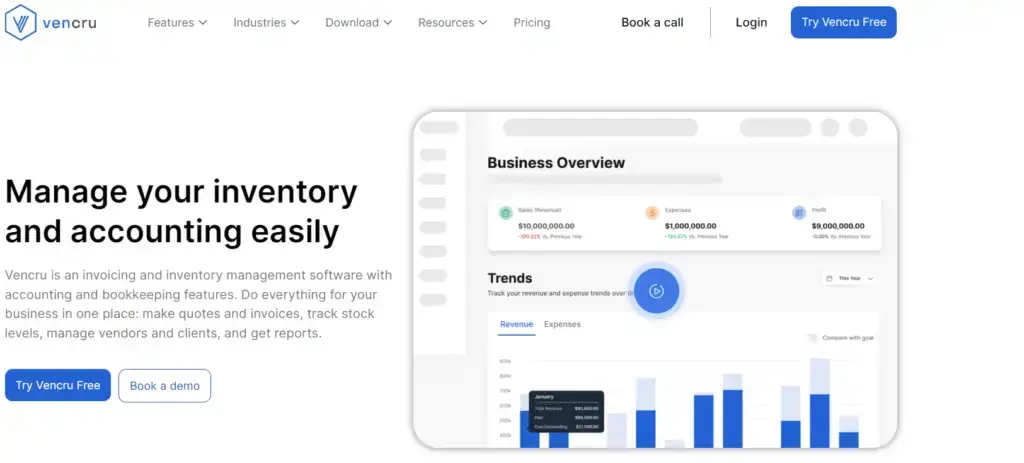Effective inventory management is crucial for business success, and understanding how to calculate inventory holding costs is a key component. In this blog, we will delve into what inventory holding costs are, how to calculate them, and ways to manage them efficiently. We’ll also provide tips for reducing these costs and offer insights into how to improve inventory management with tools like Vencru. We’ll be discussing:
- What are Inventory Holding Costs?
- How to Calculate Your Inventory Holding Costs
- Where You’ll Encounter Holding Cost
- How Much are Holding Costs on Average?
- Tips to Reducing Holding Costs
- What Does Fair Holding Cost Pricing Look Like?
What are Inventory Holding Costs?

Before we dive into calculations, let’s define what inventory holding costs in inventory management are. Simply put, inventory holding costs, also known as carrying costs, are the expenses associated with storing unsold goods. These costs encompass a range of factors, including:
- Storage Costs: These are fees associated with renting warehouse space or storage facilities. They include expenses for maintaining the physical space, utilities, and any associated operational costs required to house your inventory.
- Insurance: This refers to the coverage costs for potential damage or loss of inventory. It protects against risks such as fire, theft, or natural disasters, ensuring that you’re financially safeguarded if inventory is damaged or lost.
- Taxes: Property taxes apply to the inventory stored in warehouses or storage facilities. These taxes are levied by local governments and can vary based on the value of the inventory and the jurisdiction where it is stored.
- Obsolescence Costs: These costs arise from inventory that becomes outdated or unsellable over time. Obsolescence can result from changes in market demand, technological advancements, or shifts in consumer preferences.
- Spoilage: This includes costs related to inventory that perishes or deteriorates over time. Spoilage can occur with perishable goods or items that degrade due to age, environmental conditions, or improper handling.
How to Calculate Your Inventory Holding Cost
To accurately calculate your inventory holding cost, follow these steps:
- Determine the Average Inventory: Calculate the average amount of inventory you hold over a specific period. This can be done using the formula:
Average Inventory = (Beginning Inventory + Ending Inventory) / 2 - Identify the Cost Components: Break down the costs involved in holding inventory, including storage fees, insurance, taxes, and any other relevant costs.
- Calculate the Total Holding Costs: Sum up all the costs identified in the previous step for the inventory over the period.
- Compute the Holding Cost Percentage: To find the holding cost percentage, divide the total holding costs by the average inventory value and then multiply by 100:
Holding Cost Percentage = (Total Holding Costs / Average Inventory Value) × 100 - Calculate the Holding Cost per Unit: For a more granular view, you can calculate the holding cost per unit by dividing the total holding costs by the average number of units:
Holding Cost per Unit = Total Holding Costs / Average Number of Units
Where You’ll Encounter Holding Costs

Holding costs can appear in various aspects of your business operations. Here’s where you might encounter them:
- Warehouse Operations: These costs include expenses for renting warehouse space, utilities such as electricity and water, and managing the warehouse operations. It encompasses costs related to maintaining the facility, equipment, and personnel required to handle inventory efficiently.
- Insurance and Taxes: Regular expenses related to ensuring inventory and paying taxes on stored goods.
- Inventory Management Systems: Software costs related to tracking and managing inventory levels.
- Stock Obsolescence: Financial losses due to inventory becoming obsolete or unsellable.
How Much are Holding Costs on Average?
Holding costs typically range between 20% and 30% of the inventory value annually. However, this can vary depending on factors such as:
- Industry: Some industries, like fashion or electronics, may have higher holding costs due to rapid obsolescence.
- Location: Costs can differ based on warehouse location and associated expenses.
- Inventory Type: Perishable goods will generally incur higher holding costs compared to non-perishable items.
By benchmarking your holding costs against industry standards, you can identify areas for improvement and adjust your strategies accordingly.
Tips to Reduce Holding Costs

Reducing holding costs can significantly improve your overall profitability. Here are six practical tips to help you lower these costs:
- Optimize Inventory Levels: Use inventory management software to ensure you only stock what you need. Avoid overstocking to reduce storage and obsolescence costs.
- Implement Just-In-Time (JIT) Inventory: This strategy involves receiving goods only as they are needed, reducing the amount of inventory you need to hold.
- Negotiate with Suppliers: Work with suppliers to arrange better terms, such as lower prices or more frequent deliveries, to reduce holding costs.
- Improve Forecasting: Utilize data analytics to predict demand more accurately. Better forecasting helps in ordering the right amount of stock, thus minimizing excess inventory.
- Enhance Storage Efficiency: Optimize warehouse space by using efficient shelving and storage systems. This can reduce storage costs and improve inventory management.
- Monitor Inventory Regularly: Conduct regular audits to keep track of inventory levels and identify slow-moving items that may contribute to higher holding costs.
What Does Fair Holding Cost Pricing Look Like?
Fair holding cost pricing is based on a balanced approach that considers both your cost structure and market conditions. A fair price should:
- Cover All Costs: Ensure that all relevant holding costs are thoroughly accounted for. This includes not just storage fees, insurance premiums, and obsolescence costs, but also any additional expenses such as taxes, spoilage, and other factors affecting inventory management.
- Reflect Market Conditions: Adjust your pricing strategy to align with current industry standards and market conditions. Take into account factors like geographical location, the type of inventory, and any external economic factors that may influence cost structures and pricing strategies.
- Offer Competitive Rates: Strive to set pricing that is competitive within your market while still covering all your costs and achieving your profit goals. Balance cost recovery with market competitiveness to ensure you remain attractive to customers while maintaining financial viability.
Improve Inventory Management with Vencru

To streamline your inventory management and gain better control over holding costs, consider using inventory management software like Vencru. Vencru offers features such as real-time inventory tracking, automated reorder alerts, and detailed cost analysis, helping you optimize inventory levels and reduce holding costs. Here are four key benefits:
- Real-Time Inventory Tracking: Vencru offers real-time visibility into your inventory levels, helping you avoid overstocking and stockouts.
- Automated Reorder Alerts: The software sends automated alerts when inventory drops below set thresholds, ensuring timely reordering and reducing emergency stock purchases.
- Detailed Cost Analysis: Vencru provides comprehensive cost analysis tools, allowing you to track and minimize holding costs through in-depth expense insights.
- Advanced Forecasting: With enhanced forecasting features, Vencru helps predict future inventory needs, improve purchasing decisions, and reduce excess stock.
Conclusion
Calculating and managing inventory holding costs is essential for maintaining a smooth and efficient business operation. By understanding what holding costs are, how to calculate them, and where they arise, you can make informed decisions that help reduce these expenses. Implementing strategies such as optimizing inventory levels, improving forecasting, and using inventory management tools like Vencru can further enhance your ability to manage holding costs effectively.
Understanding and managing inventory holding costs is a continual process, but with the right tools and strategies, you can achieve significant improvements in your business operations.
Related Content






